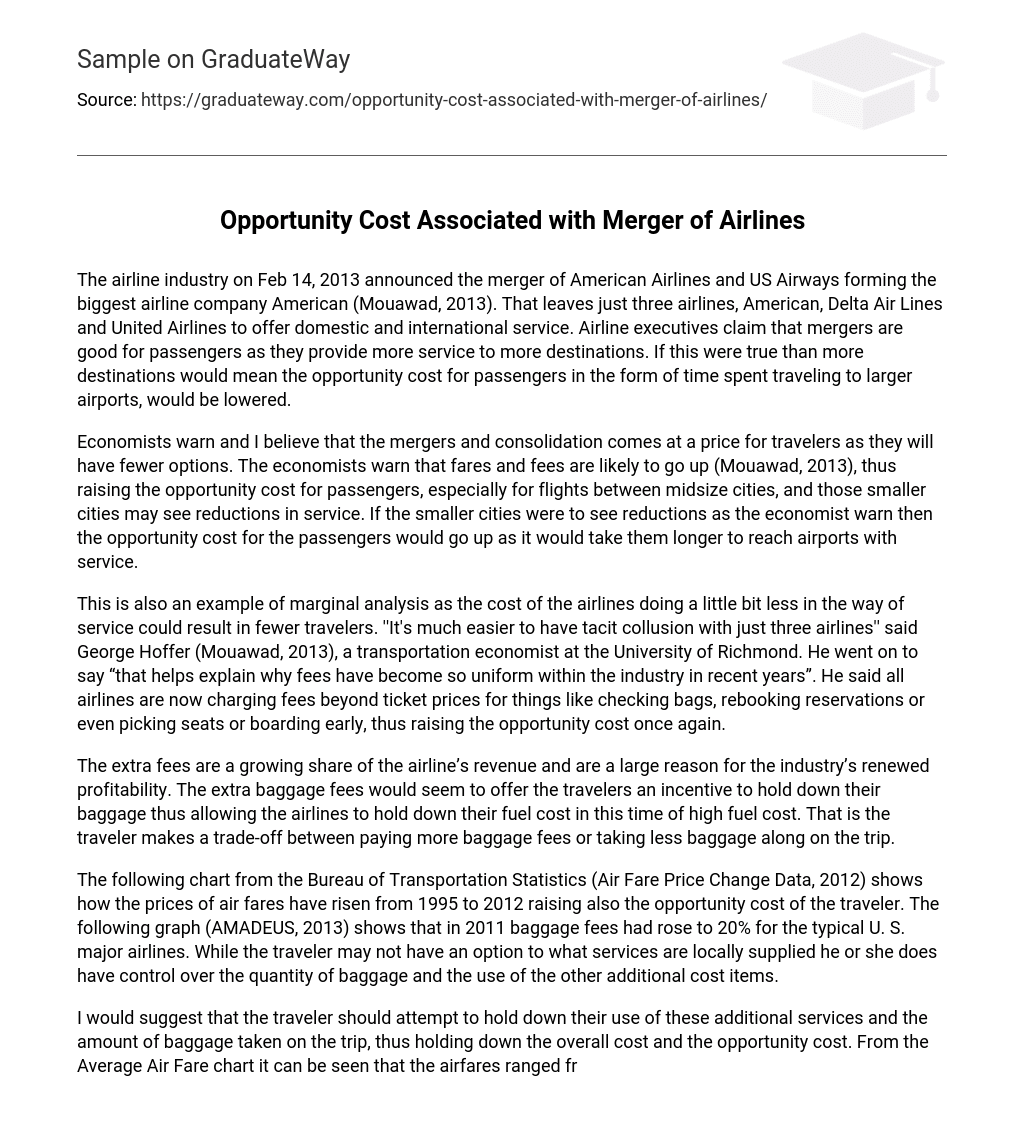The airline industry on Feb 14, 2013 announced the merger of American Airlines and US Airways forming the biggest airline company American (Mouawad, 2013). That leaves just three airlines, American, Delta Air Lines and United Airlines to offer domestic and international service. Airline executives claim that mergers are good for passengers as they provide more service to more destinations. If this were true than more destinations would mean the opportunity cost for passengers in the form of time spent traveling to larger airports, would be lowered.
Economists warn and I believe that the mergers and consolidation comes at a price for travelers as they will have fewer options. The economists warn that fares and fees are likely to go up (Mouawad, 2013), thus raising the opportunity cost for passengers, especially for flights between midsize cities, and those smaller cities may see reductions in service. If the smaller cities were to see reductions as the economist warn then the opportunity cost for the passengers would go up as it would take them longer to reach airports with service.
This is also an example of marginal analysis as the cost of the airlines doing a little bit less in the way of service could result in fewer travelers. ”It’s much easier to have tacit collusion with just three airlines” said George Hoffer (Mouawad, 2013), a transportation economist at the University of Richmond. He went on to say “that helps explain why fees have become so uniform within the industry in recent years”. He said all airlines are now charging fees beyond ticket prices for things like checking bags, rebooking reservations or even picking seats or boarding early, thus raising the opportunity cost once again.
The extra fees are a growing share of the airline’s revenue and are a large reason for the industry’s renewed profitability. The extra baggage fees would seem to offer the travelers an incentive to hold down their baggage thus allowing the airlines to hold down their fuel cost in this time of high fuel cost. That is the traveler makes a trade-off between paying more baggage fees or taking less baggage along on the trip.
The following chart from the Bureau of Transportation Statistics (Air Fare Price Change Data, 2012) shows how the prices of air fares have risen from 1995 to 2012 raising also the opportunity cost of the traveler. The following graph (AMADEUS, 2013) shows that in 2011 baggage fees had rose to 20% for the typical U. S. major airlines. While the traveler may not have an option to what services are locally supplied he or she does have control over the quantity of baggage and the use of the other additional cost items.
I would suggest that the traveler should attempt to hold down their use of these additional services and the amount of baggage taken on the trip, thus holding down the overall cost and the opportunity cost. From the Average Air Fare chart it can be seen that the airfares ranged from about 302 in 2009 to 385 in 2012, with a 20% reduction in the fares to be gained through not taking along checked baggage those figures could have been changed to 241. 60 for 2009 and 308. 00 for 2012.
This price savings and its resultant opportunity cost savings are shown in the following chart. In summary airline trips involve opportunity cost for the traveler in the form of: •Time to reach an airport that has the desired services, the opportunity cost being the time that could have been used for any other personal reason •Cost of the ticket, opportunity cost being any of the things the traveler could have spent his money on if not on airline tickets •Additional cost for: Baggage fees, opportunity cost being any of the things the traveler could have spent his money on if not on baggage fees oRebooking, the opportunity cost being the time and money spent on rebooking that could have been used differently oPicking seats, the opportunity cost being the things that the additional money could have been spent on oEarly boarding, the opportunity cost being the things that the additional money could have been spent on
Unintended consequences of holding down the travelers cost and opportunity cost would be the profits of the airlines dropping, causing them to once more raise the price of tickets and possibly cutting services even farther. By taking less baggage on trips the traveler would also have fewer things like clothes on the trip which could raise the travelers opportunity cost in terms of choice of what to wear.
References
Air Fare Price Change Data. (2012). Retrieved Feburary 15, 2013, from PlaneTickets Web site: http://www.planetickets.com/airfare.html AMADEUS. (2013). Retrieved Febrary 15, 2013, from Travel Industry Wire Web site: http://www.travelindustrywire.com/article69062Airline_Ancillary_Revenue_Projected_to_Reach_______Billion_Worldwide_in_____.html Mouawad, J. (2013, Feburary 15). The New York Times.





